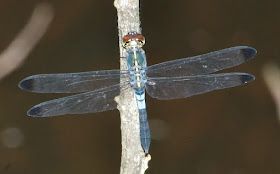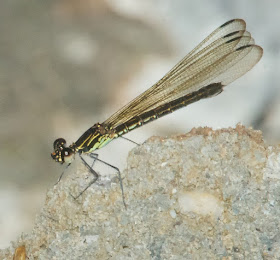The Frog Pond at Kubah National Park is a spot I am always glad to revisit. On October 8, 2014, I only had time to spend an hour or so there - not a very long stop, but enough to revisit some of the pond's usual insect habituees (to see the frogs that have made the pond famous, you have to visit after dark).
There is almost always at least one male Cratilla metallica there, guarding its territory from a vine dangling over the water.
Tyriobapta torrida males are often numerous at the pond, chasing each other about and pursuing females as they drop their eggs into the water before resuming their usual perch on a nearby tree trunk (as in the lower picture). These dragonflies have strong preferences as to where they perch, both in terms of which tree they choose and how high up on the tree they sit.
The females, posing vertically as though they were a sort of darner (Aeshnidae) rather than a typical libellulid dragonfly, blend in remarkably well with the bark of their chosen perches. The far more conspicuous males do perch on trunks when they are not at their breeding sites. According to one study (the one linked to above) they leave their perches for their territories earlier in the morning than females and may not return until after 6 PM. Males appear to have sacrificed the advantages of camouflage in the name of acquiring territories and attracting mates. Sexual selection, something first proposed by Darwin, is widely accepted today. I don't know if Tyriobapta torrida has been promoted as an example of it - though it appears to be a particularly apposite one.
This object, which I found wedged into the boardwalk that circles the pond, appears to be the remains of an egg mass from one of the rhacophorid frogs that resort here by night to breed. This particular attempt seems to have been a failure, though it certainly has provided a bonanza for the assortment of flies crawling over it.
The bonanza was also appreciated by this Great Marquis (Euthalia [Bassarona] dunya), a nymphalid butterfly.
Northerners may not be used to the idea of butterflies as scavengers, but there are many tropical butterflies, particularly forest floor nymphalids, for whom carrion is an important food and, possibly nitrogen (but see this study), source. Butterflies like these may rarely, if ever, visit flowers.
Finally, I found this Heliocypha biseriata female - but at the road edge. These damselflies like running water with stones to perch on, and the pond is probably too muddy and still for their tastes.
















No comments:
Post a Comment